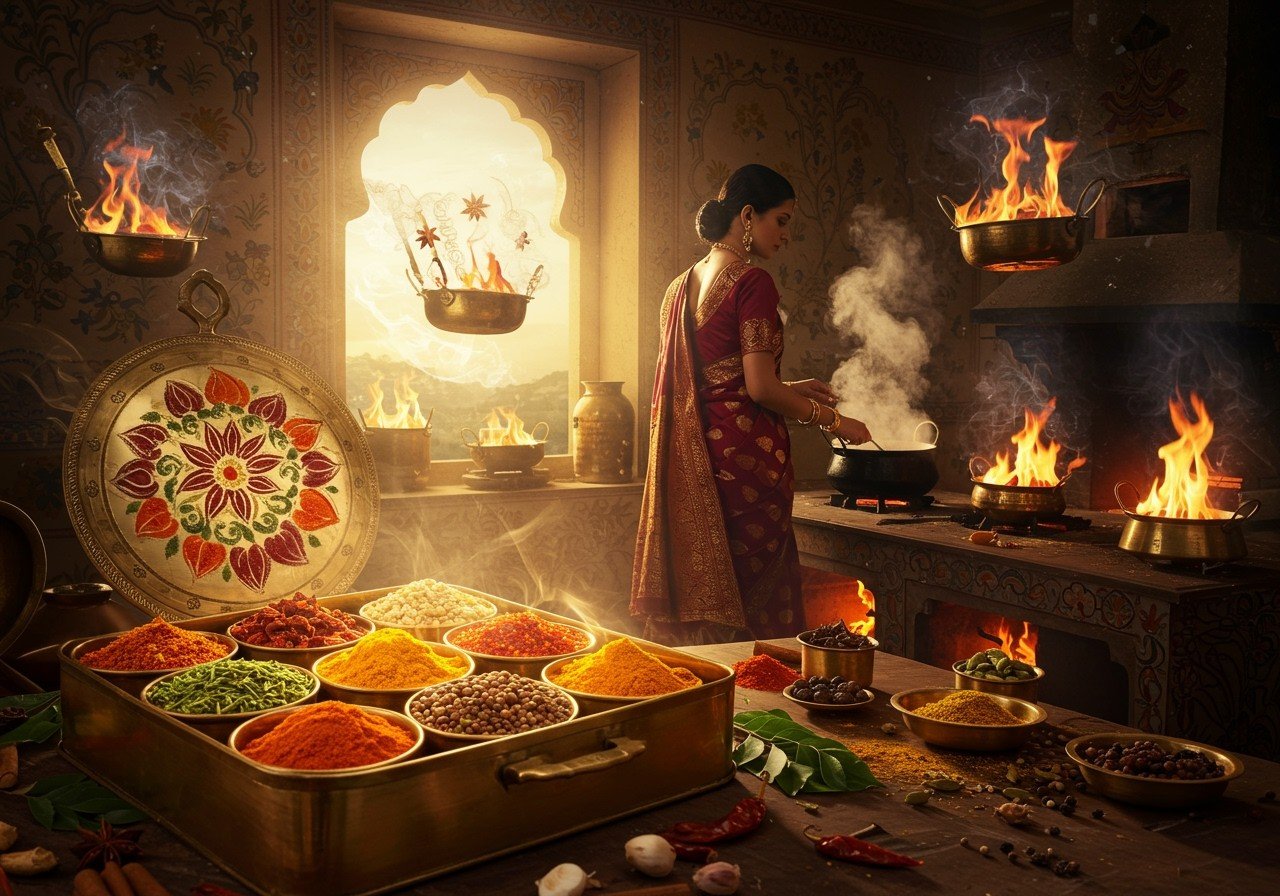
Traditional Indian cooking is a captivating blend of history, culture, and vibrant flavors. It’s an art form passed down through generations, preserving a rich culinary heritage. By mastering techniques like tadka (tempering spices), bhuna (sautéing), and dum (slow cooking), and understanding regional variations, we keep the heart of Indian cuisine beating strong.
Incorporating freshly ground spices, marinating, and fermenting unlocks authentic tastes that define Indian food. Whether it’s the shared joy of a meal during festivals or the sacred offering to deities, food holds deep meaning in our traditions.
As we embrace modern life, let’s also honor our culinary roots. Cooking traditional Indian dishes connects families and keeps our culture vibrant. So, gather your ingredients, light the stove, and immerse yourself in this art.
Exploring the Nuances of Traditional Indian Cooking
Indian cooking techniques, while varying regionally, share core methods like tempering spices in hot oil or ghee (tadka). This foundational technique releases the aromatic oils from spices, infusing the dish with complex flavors. Another traditional method uses a tandoor (clay oven) for dishes like naan and tandoori chicken, imparting a smoky char. While Indian cuisine utilizes standard methods like sautéing, frying, boiling, and grilling, it’s the unique techniques like tadka and the masterful use of spice blends that truly elevate the flavors.
Understanding regional specialties and terms is key to mastering Indian cooking. For instance, the word “dum” refers to a slow-cooking technique where food is sealed in a pot and cooked over low heat, allowing the flavors to meld and intensify. Exploring these regional nuances adds depth and appreciation for the diverse culinary landscape of India.
Delving into Regional Flavors and Cultural Significance
India’s culinary tapestry is richly woven with regional diversity. North Indian cuisine is known for its creamy textures and use of dairy, exemplified in dishes like Butter Chicken. South Indian cuisine tantalizes with spicy and tangy flavors, featuring rice as a staple and the prominent use of coconut and tamarind. East India showcases the use of mustard oil and fresh fish, while West India carries influences from Portuguese and Parsi traditions. Central India emphasizes millets and wood-fired cooking, creating hearty and earthy flavors. Each region offers a unique culinary adventure, reflecting the diverse ingredients and cultural influences that shape Indian gastronomy.
Food in Indian culture transcends mere sustenance; it represents hospitality, celebration, and tradition. From elaborate feasts during weddings to the daily ritual of offering food to deities, it holds a sacred place. The act of sharing a meal is a cornerstone of community and connection, strengthening bonds and expressing love. This cultural significance elevates Indian cooking beyond the culinary realm, making it an integral part of life’s tapestry.
Enhancing Your Culinary Journey with Poojn.in
Poojn.in, India’s largest Dashakarma bhandar, offers premium ingredients essential for authentic Indian cooking. We specialize in providing pure and high-quality turmeric (Haldi), a cornerstone of both culinary and ceremonial traditions.
-
Premium Turmeric Powder: Our turmeric powder delivers the true flavor and aroma crucial for traditional dishes. It acts as both a natural colorant and flavor enhancer, adding a rich golden hue and earthy warmth. Sourced and processed meticulously, it retains its curcumin content, ensuring you receive the full benefits of this sacred spice. Discover the difference of pure turmeric at Poojn.in.
-
Green Mung Dal: A staple in Indian cuisine, our Green Mung Dal is perfect for traditional recipes. We ensure authenticity and convenience, delivering quality ingredients right to your doorstep. Find the finest Green Mung Dal at Poojn.in.
-
Essential Spices and Ingredients: Explore our wide selection of authentic Indian spices and ingredients, each carefully chosen for quality and purity. We offer everything you need to create authentic Indian dishes at home, from aromatic spices to essential lentils and grains. Explore our complete range at Poojn.in.
With Poojn.in, you can trust that you’re getting authentic ingredients, making your traditional Indian cooking experience both convenient and deeply fulfilling.
Frequently Asked Questions
What defines traditional Indian cooking?
Traditional Indian cooking is characterized by techniques like tadka (tempering spices), bhuna (sautéing), dum (slow cooking), and the use of a tandoor (clay oven). These methods, combined with fresh spices and regional variations, create the unique flavors of Indian cuisine.
What is the cultural significance of food in India?
Food in India is deeply intertwined with culture and tradition. It’s a symbol of hospitality, an expression of celebration, and a way to honor deities. Sharing meals is a fundamental part of social and religious life, reinforcing community bonds and passing down culinary heritage.
How do regional variations influence Indian cuisine?
India’s diverse regions boast distinct culinary styles. North Indian cuisine is known for its rich, creamy dishes, while South Indian cuisine offers spicy and tangy flavors. East India emphasizes fish and mustard oil, West India incorporates Portuguese and Parsi influences, and Central India features hearty, earthy dishes cooked with millets and wood fire. These regional variations showcase the vast culinary landscape of India.


